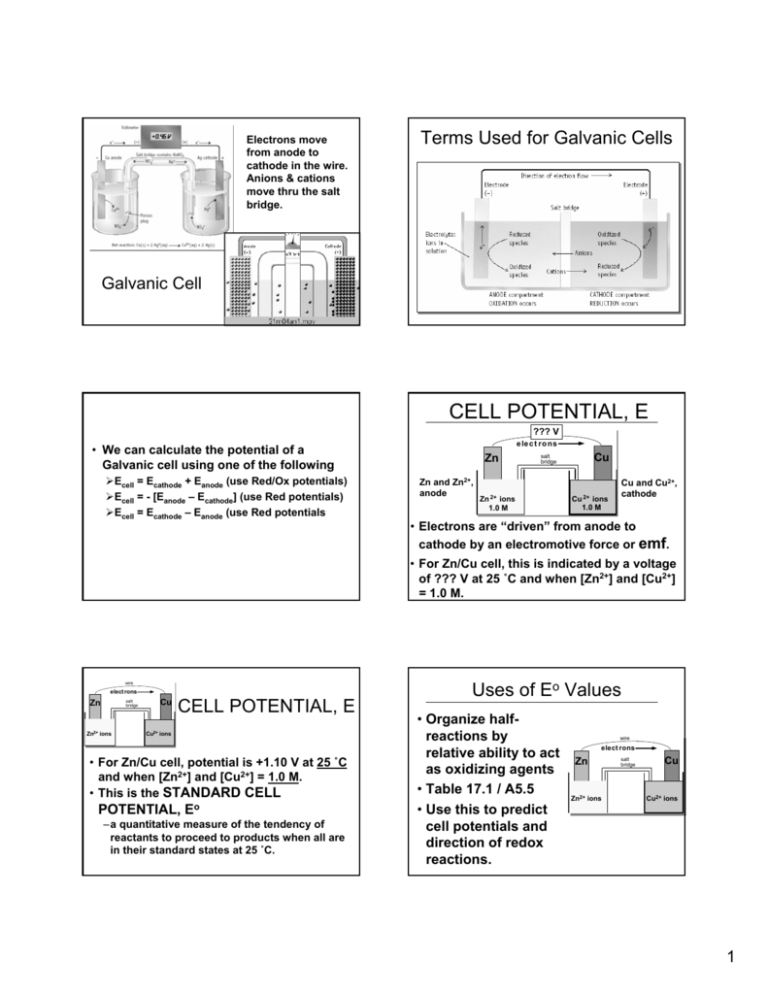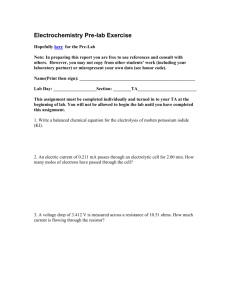Chapter 17
advertisement

Electrons move from anode to cathode in the wire. Anions & cations move thru the salt bridge. Terms Used for Galvanic Cells Galvanic Cell CELL POTENTIAL, E wire V ??? e le c t ro ns • We can calculate the potential of a Galvanic cell using one of the following ¾Ecell = Ecathode + Eanode (use Red/Ox potentials) ¾Ecell = - [Eanode – Ecathode] (use Red potentials) ¾Ecell = Ecathode – Eanode (use Red potentials Zn Zn and Zn2+, anode Cu salt bridge Zn 2+ ions 1.0 M Cu 2+ ions 1.0 M Cu and Cu2+, cathode • Electrons are “driven” from anode to cathode by an electromotive force or emf. • For Zn/Cu cell, this is indicated by a voltage of ??? V at 25 ˚C and when [Zn2+] and [Cu2+] = 1.0 M. wire elect rons Zn salt bridge Zn2+ ions Cu CELL POTENTIAL, E Cu2+ ions • For Zn/Cu cell, potential is +1.10 V at 25 ˚C and when [Zn2+] and [Cu2+] = 1.0 M. • This is the STANDARD CELL POTENTIAL, Eo –a quantitative measure of the tendency of reactants to proceed to products when all are in their standard states at 25 ˚C. Uses of Eo Values • Organize halfreactions by relative ability to act as oxidizing agents • Table 17.1 / A5.5 • Use this to predict cell potentials and direction of redox reactions. wire elect rons Zn Zn2+ ions salt bridge Cu Cu2+ ions 1 Standard Redox Potentials, Eo oxidizing ability of ion Eo (V) Cu2+ + 2e- Cu +0.34 2 H+ + 2e- H2 0.00 Zn2+ + 2e- Zn -0.76 reducing ability of element Any substance on the right will reduce any substance higher than it on the left. • Zn can reduce H+ and Cu2+. • H2 can reduce Cu2+ but not Zn2+ • Cu cannot reduce H+ or Zn2+. Using Standard Potentials, Eo Think of it this way… • What happens when you place Mg(s) in a solution of Cu2+(aq)? (with a little acid) – Mg goes into solution – Cu plates out. • In terms of the Reduction Potentials – The more negative the value the more active the substance. – So, they tend to want to go into solution. – Therefore those substances are the Anode Eo for a Voltaic Cell Volts • In which direction do the following Cd reactions go? Fe Salt Bridge • Cu(s) + 2 Ag+(aq) ---> Cu2+(aq) + 2 Ag(s) • 2 Fe2+(aq) + Sn2+(aq) ---> 2 Fe3+(aq) + Sn(s) • What is Eonet for the overall reaction? Cd2+ Cd --> Cd2+ + 2eor Cd2+ + 2e- --> Cd Fe2+ Fe --> Fe2+ + 2eor Fe2+ + 2e- --> Fe All ingredients are present. Which way does reaction proceed? Eo for a Voltaic Cell Volts Cd Fe Salt Bridge Cd2+ Fe2+ Overall reaction Fe + Cd2+ ---> Cd + Fe2+ Eo = E˚cathode - E˚anode = (-0.40 V) - (-0.44 V) = +0.04 V From the table, you see • Fe is a better reducing agent than Cd • Cd2+ is a better oxidizing agent than Fe2+ More About Calculating Cell Voltage Assume I- ion can reduce water. 2 H2O + 2e- ---> H2 + 2 OHCathode 2 I- ---> I2 + 2eAnode ------------------------------------------------2 I- + 2 H2O --> I2 + 2 OH- + H2 Assuming reaction occurs as written, E˚net = E˚cathode - E˚anode = (-0.828 V) - (+0.535 V) = -1.363 V Minus E˚ means rxn. occurs in opposite direction 2 CELL POTENTIALS, Eo Can’t measure 1/2 reaction Eo directly. Therefore, measure it relative to a STANDARD HYDROGEN CELL, SHE. 2 H+(aq, 1 M) + 2e- <----> H2(g, 1 atm) Eo = 0.0 V Which is the Anode/Cathode? • Standard notation has the Anode on the left and the Cathode on the right. • In a Galvanic cell, you always want to have a positive Ecell. • Out of the two components (in terms of the standard reduction potential) Zn/Zn2+ half-cell hooked to a SHE. Eo for the cell = +0.76 V Negative electrode Zn Supplier of electrons Volts - + Positive electrode Salt Bridge H+ Zn2+ 2+ + 2eZn -->Zn Zn 2+ Zn + 2eOxidation OXIDATION Anode ANODE H2 Acceptor of electrons 2 H+ + 2e- --> H2 2 H+ + 2eH Reduction 2 REDUCTION Cathode CATHODE Is E˚ related to ∆G? YES! – The more negative one is the ANODE – The more positive one is the CATHODE Michael Faraday 1791-1867 Originated the terms anode, cathode, anion, cation, electrode. Discoverer of • electrolysis • magnetic props. of matter • electromagnetic induction • benzene and other organic chemicals Was a popular lecturer. Eo and ∆Go Eo is related to ∆Go, the free energy change for the reaction. ∆Go = - n F Eo where F = Faraday constant = 9.6485 x 104 J/V•mol and n is the number of moles of electrons transferred Michael Faraday 1791-1867 3 E at Nonstandard Conditions RT E = Eo − ln(Q) nF Eo and ∆Go ∆Go = - n F Eo For a product-favored reaction Reactants ----> Products ∆Go < 0 and so Eo > 0 Eo is positive For a reactant-favored reaction Reactants <---- Products ∆Go > 0 and so Eo < 0 Eo is negative • The NERNST EQUATION • E = potential under nonstandard conditions • n = no. of electrons exchanged Electrolysis of Aqueous NaOH Electrolysis Using electrical energy to produce chemical change. Sn2+(aq) + 2 Cl-(aq) ---> Sn(s) + Cl2(g) Electric Energy ----> Chemical Change Anode (+) 4 OH- ---> O2(g) + 2 H2O + 4eCathode (-) SnCl2(aq) 4 H2O + 4e- --->2 H2 + 4 OHEo for cell = -1.23 V Cl2 Sn Electrolysis Electric Energy ---> Chemical Change • Electrolysis of molten NaCl. • Here a battery + “pumps” electrons Anode from Cl- to Na+. • Polarity of electrodes is reversed from batteries. Electrolysis of Molten NaCl electrons BATTERY Cathode Cl- Na+ 4 Electrolysis of Molten NaCl BATTERY 2 Cl- ---> Cl2(g) + 2e- + Anode Cathode Cl- Anode (+) 2 Cl- ---> Cl2(g) + 2eCathode (-) 2 H2O + 2e- ---> H2 + 2 OHo E for cell = -2.19 V Note that H2O is more easily reduced than Na+. Anode (+) electrons Na+ Cathode (-) Na+ Electrolysis of Aqueous NaCl + e- ---> Na Eo for cell (in water) = E˚c - E˚a = - 2.71 V – (+1.36 V) = - 4.07 V (in water) External energy needed because Eo is (-). Electrolysis of Aqueous NaCl electrons BATTERY + Anode Cathode Cl- Na + H2O Also, Cl- is oxidized in preference to H2O because of kinetics. Electrolysis of Aqueous NaI • Cells like these are the source of NaOH and Cl2. • In 1995: 25.1 x 109 lb Cl2 and 26.1 x 109 lb NaOH Also the source of NaOCl for use in bleach. Electrolysis of Aqueous CuCl2 Anode (+) 2 Cl- ---> Cl2(g) + 2e- Eo for cell = -1.02 V Note that Cu is more easily reduced than either H2O or Na+. Electrolytic Refining of Copper electrons Cathode (-) Cu2+ + 2e- ---> Cu Anode (+): 2 I- ---> I2(g) + 2eCathode (-): 2 H2O + 2e- ---> H2 + 2 OHEo for cell = -1.36 V BATTERY + Anode Cathode Cl- Cu2+ H2O Impure copper is oxidized to Cu2+ at the anode. The aqueous Cu2+ ions are reduced to Cu metal at the cathode. 5 Alcoa http://www.alcoa.com Producing Aluminum 2 Al2O3 + 3 C ---> 4 Al + 3 CO2 Charles Hall (1863-1914) developed electrolysis process. Founded Alcoa. • World's leading producer of primary aluminum, fabricated aluminum, and alumina. Active in all major aspects of the industry — technology, mining, refining, smelting, fabricating and recycling. • Alcoa's aluminum products and components are used worldwide in aircraft, automobiles, beverage cans, buildings, chemicals, sports and recreation, and a wide variety of industrial and consumer applications, including such Alcoa consumer brands as Alcoa® wheels, Reynolds Wrap® aluminum foil, and Baco® household wraps. • Vital statistics: 120,000 Alcoans in 41 countries, $21.5 billion in revenues Quantitative Aspects of Electrochemistry Consider electrolysis of aqueous silver ion. Ag+ (aq) + e- ---> Ag(s) 1 mol e- ---> 1 mol Ag If we could measure the moles of e-, we could know the quantity of Ag formed. But how to measure moles of e-? Current = I (amps) Quantitative Aspects of Electrochemistry I (amps) charge passing time C e- = 1.60 x 10-19 6.02 x 1023 e - mol = 96,500 C/mol e- = 1 Faraday Quantitative Aspects of Electrochemistry coulombs I (amps) = seconds solution 1.50 amps flow thru a for 15.0 min. What mass of Ag metal is deposited? Solution (a) Calc. charge Charge (C) = current (A) x time (t) = (1.5 amps)(15.0 min)(60 s/min) = 1350 C Current = Ch arge on 1 mol e - coulombs seconds Quantitative Aspects of Electrochemistry coulombs seconds But how is charge related to moles of electrons? charge passing time = = I (amps) = coulombs seconds 1.50 amps flow thru a Ag+(aq) solution for 15.0 min. What mass of Ag metal is deposited? Ag+(aq) Solution (a) Charge = 1350 C (b) Calculate moles of e- used 1350 C • (c) 1 mol e = 0.0140 mol e 96, 500 C Calc. quantity of Ag 0.0140 mol e - • 1 mol Ag = 0.0140 mol Ag or 1.51 g Ag 1 mol e - 6 Quantitative Aspects of Electrochemistry Quantitative Aspects of Electrochemistry The anode reaction in a lead storage battery is Pb(s) + HSO4-(aq) ---> PbSO4(s) + H+(aq) + 2eIf a battery delivers 1.50 amp, and you have 454 g of Pb, how long will the battery last? The anode reaction in a lead storage battery is Pb(s) + HSO4-(aq) ---> PbSO4(s) + H+(aq) + 2eIf a battery delivers 1.50 amp, and you have 454 g of Pb, how long will the battery last? Solution a) 454 g Pb = 2.19 mol Pb b) Calculate moles of e- Time (s) Solution a) 454 g Pb = 2.19 mol Pb b) Mol of e- = 4.38 mol c) Charge = 423,000 C 2.19 mol Pb • c) 2 mol e = 4.38 mol e 1 mol Pb Calculate charge 4.38 mol e- • 96,500 C/mol e- = 423,000 C d) Calculate time Time (s) = 423, 000 C 1.50 amp = Charge (C) I (amps) About 78 hours = 282, 000 s 7









